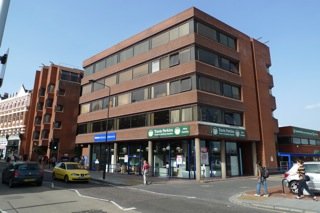Ambitious scope for local development plan
We’re inching nearer to a final Neighbourhood Development Plan. There’s a meeting this Thursday to discuss the second draft plan.
At the time of writing the draft, the issue of the southern boundary had not been resolved. Since then, however, the results of the WHGARA (West Hamsptead Gardens Area Residents Association) vote on the matter have been released and 75% of people were in favour of being part of the plan area rather than sitting outside it. This is almost certain to mean that the area covered will exactly match the ward boundaries of West Hampstead and Fortune Green.
 |
| 156 West End Lane – one of the sites up for development |
The draft plan is very much a work in progress, and still has some gaps. Nevertheless, two things are worth looking at even at this early stage. The first is the overall scope of the plan, the second is the introduction of the core policies.
Scope
If you read the write-up of the public meeting back at the end of October, you’ll know that Neighbourhood Development Plans can vary enormously in scope from all-encompassing town plans to single-issue plans. The West Hampstead & Fortune Green plan certainly drifts closer to the first idea. Broadly, it seeks to influence building development (location, form, use of Section 106 money), business and economic development (retail mix, high street feel), street environment (roads, parking, cycling, pedestrians), public transport, environment (green space, trees), community, and public services (schools, healthcare). Some of these area are easier to influence than others – some lie firmly within Camden’s remit, other are the purview of larger bodies such as TfL or City Hall. But it would be hard to argue that the plan lacks ambition.
Policies
The draft plan outlines 12 core policies. Many of these are not especially controversial and only the hard core members of the “flatten everything to build more houses” brigade are likely to object to limitations on building height, or a presumption that green space is a good thing.
It is worth reiterating the message of policies 1 and 2 – namely that the bulk of dense housing development should be in the designated growth area (that is broadly the area between and around the stations and railway tracks), while the rest of West Hampstead is allowed to retain its current feel. Whether this will lead to two very distinctive town centres developing – one to the south and one to the north end of West End Lane – and whether this is desirable is up for debate. I can well imagine the good burghers of Fortune Green grumbling about how busy it is around the interchange while they enjoy the peace and quiet of the leafy suburbs the rest of the time.
- New development should be focused on providing a range of housing and housing types, including social and affordable housing and 3-4 bedroom homes for families. The vast majority of new housing and development should be located in the ‘West Hampstead growth area’.
- Outside the growth area, new development should be on a much smaller scale.
- New buildings in the growth area should be no higher than xx storeys; outside this area new buildings should be no higher than xx storeys.
- New developments should promote high quality design which fit in with their surroundings, especially in terms of height, appearance and design.
- Conservation areas should promote high design standards and have policies which are strongly enforced.
- Development in the Area should also be focused on providing new jobs and attracting new businesses to the Area. Existing businesses, and the land they occupy, should be protected and encouraged.
- There is an urgent need for ongoing improvements to public transport in the Area, particularly the three rail stations.
- Future development should protect, preserve and enhance existing green/open space and provide new green/open space in new developments.
- Provide as much space as possible for pedestrians and promote ease of movement through the Area.
- Protect the existing public services and community facilities in the Area and provide new services/facilities as the population of the Area grows.
- Provide an environment that is suitable for a mixed community, including young people, old people, families and those from a range of social backgrounds.
- In all developments, there should be a presumption in favour of preserving the look, feel and views of the Area.
The next meeting of the Neighbourhood Development Forum is at 7.30pm at Emmanuel Church on Thursday. It’s open to all, so why not come along and find out more.

I haven’t attended these meetings because after many years on local campaign groups, I get depressed even thinking about trying to influence Camden or Westminster about anything. However, having read the above, one thing I will say is that any new ‘growth area’, however important some people think it is, will put increased pressure on public transport – already so crowded in peak periods you often can’t get on it; doctors and dentists; schools; other local amenities. Developers can put 50, 100 or 200 homes in, but where are the services that need to go along with them?